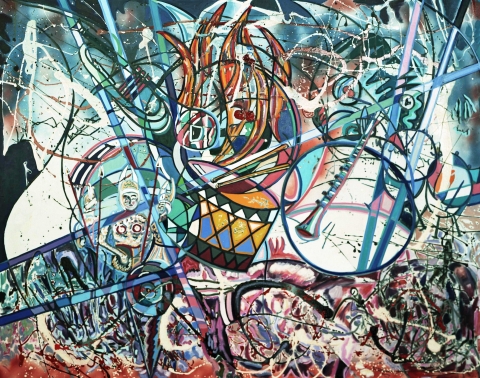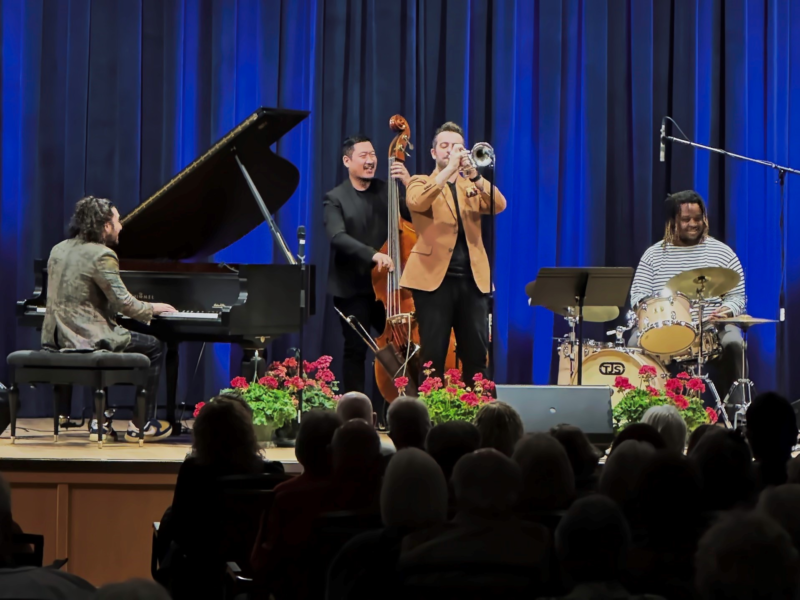Imagine waking up to a world filled with color, excitement, passion and energy. That was my childhood experience. My dad always made our worlds brighter, filling my head and my sister’s with ideas about the endless possibilities that awaited us. Nothing was impossible, the word “no” did not exist and frankly, the world was to be our playground.
From art museums in Jerusalem to the canals of Venice, we traveled the globe. Not only were we exposed to the beauty in the world, but also the shadows and darkness, and often the light which emerges from such places. So it’s no surprise that my father, Gerald Siegel, a self-taught artist, chooses to paint both the horror and the beauty found in a universe filled with grace.
Born in Frankfurt, Germany and raised in Africa and New York, my father began painting at age six. His first sale came when he was 10; a neighbor saw one of his canvases and offered $1.50 for it.
My father’s passion flows through his paintbrush, be it a rendition of the world’s greatest composers or a scene relating to the Holocaust. His latest creation is one about Kristallnacht, also known as the Night of Broken Glass, when on the night of Nov. 9, 1938, there were a series of coordinated attacks against the Jewish people in Nazi Germany and parts of Austria. German authorities watched as Jewish people were killed, more than a thousand synagogues were destroyed and more than 7,000 Jewish businesses attacked and damaged.
“The reason I painted Kristallnacht was that my grandparents lived through this horrific night of shattered glass where all the synagogues in Germany were destroyed in one night and Hitler’s Nazi government claimed no knowledge and responsibility,” my father says. “They said it was a spontaneous occurrence.”
He further explains: “One of the reasons I was compelled to express this night on a canvas was because one of my best friends, who is Jewish, had never even heard of this horrific night of terror and destruction, where the streets were filled with the shattered glass of synagogues nationwide.”
The painting depicts elements of that night — synagogues burning and those responsible watching as if it were sheer entertainment. “I paint my feelings onto the canvas. Some are pleasant and some are heartbreaking,” he says.
My father is no stranger to gut-wrenchingly difficult paintings. His painting of Sept. 11, 2001, titled, “The Day the World Cried,” emerged out of sheer anger. “I was so affected, so furious about what happened that I needed to express myself. Charcoal in hand, I drew out my emotions. One canvas turned into another and another, until there were five canvases across, 20 feet long, drawn out,” he says.
His paintbrush flew across the tightly stretched surface, bringing depth and power into a once blank area. Overwhelmed with the need to make a statement, he dropped everything he was doing and painted for a month solid. The resulting painting is as shocking as the day itself. When I ask him, “What were you thinking?” he looks at me with darts flying out of his brown eyes and answers, “I was angry at the futility and at the destruction of innocent people. What immediately comes to mind was Picasso’s ‘Guernica.’ He, too, was angry at the fascists, just like I was furious with the terrorists.”
The painting is filled with vivid symbols. It silences voices and seems to bring out sentiment. In the center of the painting is the American flag being raised, showing the hope of the American people, and the coming together of a nation. The enormous canvas shows hands reaching up frantically out of the rubble of the fallen towers. The time of the attack is illustrated by watches, and wedding rings show the love lost, and families ripped apart because of this tragedy.
“The horrific images were all over the place, stories of the firemen, of the victim’s families, and all the courage of the American people,” my father says.
“Did you plan the painting out?” I ask. He explains, “I sit in front of the canvas and work; my emotions pour out through the paintbrush. It’s not something I can plan. This was the reality around me, and I put the images together into a solid body of work. Art changes the way we live. Certain art changes the way the world looks.”
My father also paints happy canvases which are equally as thoughtful. One that reflects his love of travel and exploration is “Dream Time at the Sydney Opera House.” He explains the painting’s evolution: “When I first saw the Sydney Opera House, I was in an outdoor restaurant across the way. I returned every night for four nights and watched the building from late afternoon to early evening.”
The more he looked at it, the more the shapes began to form in his mind and an unusual shape conjured up for him the idea of a sailboat. “I looked at the Opera House and then I broke it up into its component parts and made a regatta of sailboats coming out of it.” The central image of the painting is the opera house, and it’s flanked by the art of the Aborigines, the original tribal inhabitants of the Australian continent. He painted ancient representations of animals, handprints and a man playing the didgeridoo, a traditional instrument. It is meant to depict the ongoing struggle between original and modern Australian culture.
My father also created a series of paintings on composers. He smiles as he says, “An interesting development occurred when I painted the canvas depicting Beethoven’s Ninth Symphony. I put a piano in [the painting]. It suddenly dawned on me, listening to the piece … there is no piano in the whole symphony. Hence, when you look at the Beethoven painting there is a piano. Fortunately, for my canvas, he wrote many pieces that utilize pianos in them, so I did not have to destroy it.
As an artist, my father uses color just as a composer uses notes to compose his compositions. The series depicts a variety of composers and musical styles; jazz, Beethoven, Tchaikovsky, Verdi’s “Aida,” and John Philip Sousa are some of the themes.
He explains, “Painting for me is an expression of the beauty this world offers. It gives me an opportunity to capture a moment in time, interpret it and share it with the world. Life is made up of these individual moments, and once you have them on the canvas, they have a life of their own and live forever.”
If you would like to see more of Gerald Siegel’s paintings, visit geraldsiegelstudio.com.






